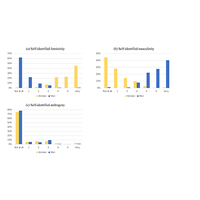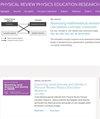调查学生在物理入门课程中对女性气质、男性气质和雌雄同体气质的自我认同和反映评价
IF 2.6
2区 教育学
Q1 EDUCATION & EDUCATIONAL RESEARCH
Physical Review Physics Education Research
Pub Date : 2024-02-27
DOI:10.1103/physrevphyseducres.20.010110
引用次数: 0
摘要
在物理教育研究领域,已有大量研究致力于调查性别认同与物理学习之间的关系。然而,这些研究主要采用二元性别测量方法,这可能会限制可探讨的研究问题的范围,并妨碍发现重要的见解。在本研究中,我们调整了先前研究中的梯度测量方法,以调查学生在代数和微积分入门物理课程中自我认同的女性气质、男性气质和雌雄同体气质,以及他们对女性气质、男性气质和雌雄同体气质的反映性评价(即对他人如何看待他们的看法)。梯度测量法的使用揭示了学生自我认同的女性气质、男性气质和雌雄同体气质在女性和男性二元类别中的显著差异,为物理学中的性别动态提供了新的视角。我们发现,在以微积分为基础的课程中,自我认同的女性人数较少,她们倾向于认为自己比别人眼中的自己更阳刚,更阴柔。同样,有色人种学生也比白人学生更倾向于认为自己比别人认为的更男性化。通过结构方程建模,我们发现学生的性别污名意识在调解女性身份和有色人种学生对观察到的差异的影响方面发挥了重要作用。此外,我们还发现,在代数和微积分物理课程中,女性也表现出一种倾向,即认为自己比她们认为的他人眼中的自己更雌雄同体,而这一现象也与性别成见意识有关。此外,我们的分析表明,即使控制了性别和种族因素,微积分课程的学生也倾向于具有更高水平的性别鄙视意识。我们的研究结果凸显了渐进式性别测量在加深我们对物理教育中性别相关问题的理解方面的潜力,揭示了学生的性别认同、他人的看法和他们在该领域的教育经历之间复杂的相互作用。本文章由计算机程序翻译,如有差异,请以英文原文为准。

Investigating students’ self-identified and reflected appraisal of femininity, masculinity, and androgyny in introductory physics courses
In the field of physics education research, numerous studies have been dedicated to investigating the relationship between gender identity and physics learning. However, these studies have predominantly employed binary gender measurement methods, which may limit the range of research questions that can be explored and impede the discovery of crucial insights. In this study, we adapted gradational measures from prior research to investigate students’ self-identified femininity, masculinity, and androgyny, as well as their reflected appraisal of femininity, masculinity, and androgyny (i.e., perceptions of how others perceive them) in both algebra-based and calculus-based introductory physics courses. The use of gradational measures revealed significant variation in students’ self-identified femininity, masculinity, and androgyny within the binary categories of women and men, providing new insights into gender dynamics in physics. We found that self-identified women in the calculus-based courses, where they are underrepresented, tend to perceive themselves as more masculine and less feminine than how they believe others perceive them. Similarly, students of color are also more likely than White students to perceive themselves as more masculine than they believe others perceive them. Using structural equation modeling, we found that students’ gender stigma consciousness plays an important role in mediating the effects of identifying as women and students of color on the observed discrepancies. Additionally, we found that women also exhibit a tendency to perceive themselves as more androgynous than they believe others perceive them in both algebra-based and calculus-based physics courses, and this phenomenon is also related to gender stigma consciousness. Moreover, our analyses revealed that students in the calculus-based courses tend to have a higher level of gender stigma consciousness even after controlling for gender and race. Our findings underscore the potential of gradational gender measurements in deepening our understanding of gender-related issues in physics education, shedding light on the complex interplay between students’ gender identity, perceptions from others, and their educational experiences in the field.
求助全文
通过发布文献求助,成功后即可免费获取论文全文。
去求助
来源期刊

Physical Review Physics Education Research
Social Sciences-Education
CiteScore
5.70
自引率
41.90%
发文量
84
审稿时长
32 weeks
期刊介绍:
PRPER covers all educational levels, from elementary through graduate education. All topics in experimental and theoretical physics education research are accepted, including, but not limited to:
Educational policy
Instructional strategies, and materials development
Research methodology
Epistemology, attitudes, and beliefs
Learning environment
Scientific reasoning and problem solving
Diversity and inclusion
Learning theory
Student participation
Faculty and teacher professional development
 求助内容:
求助内容: 应助结果提醒方式:
应助结果提醒方式:


